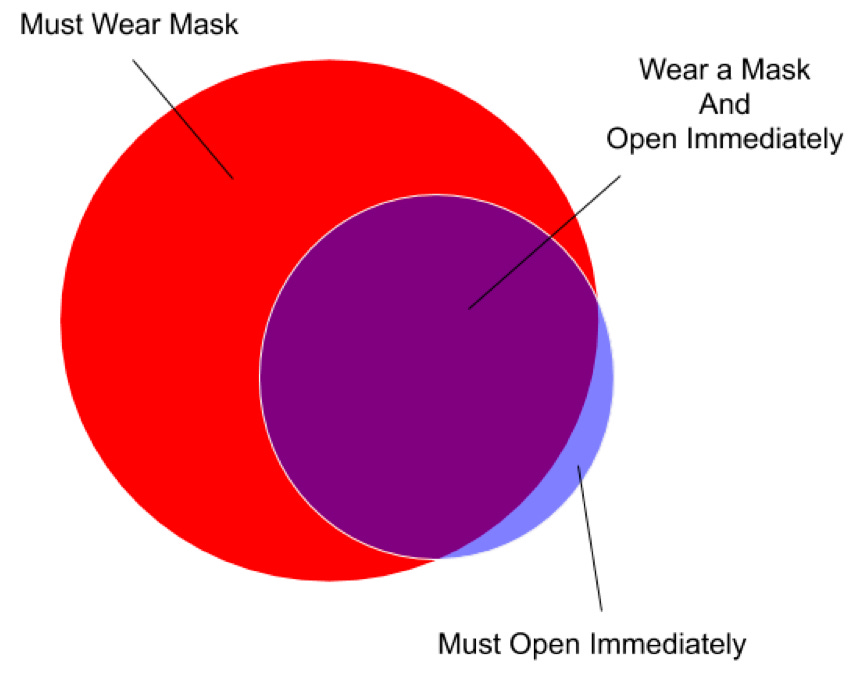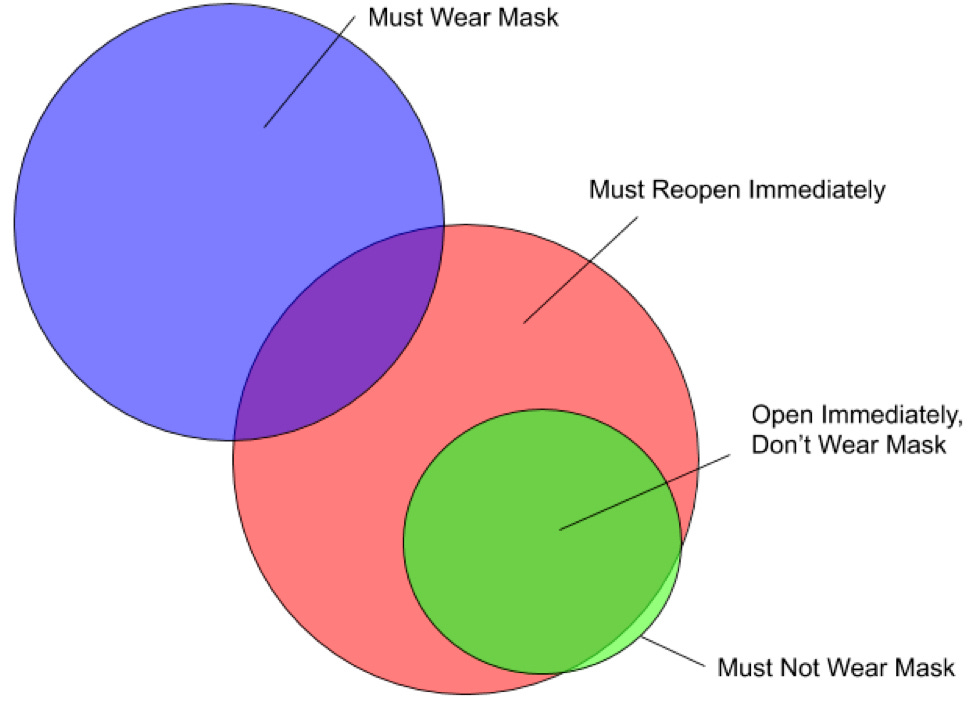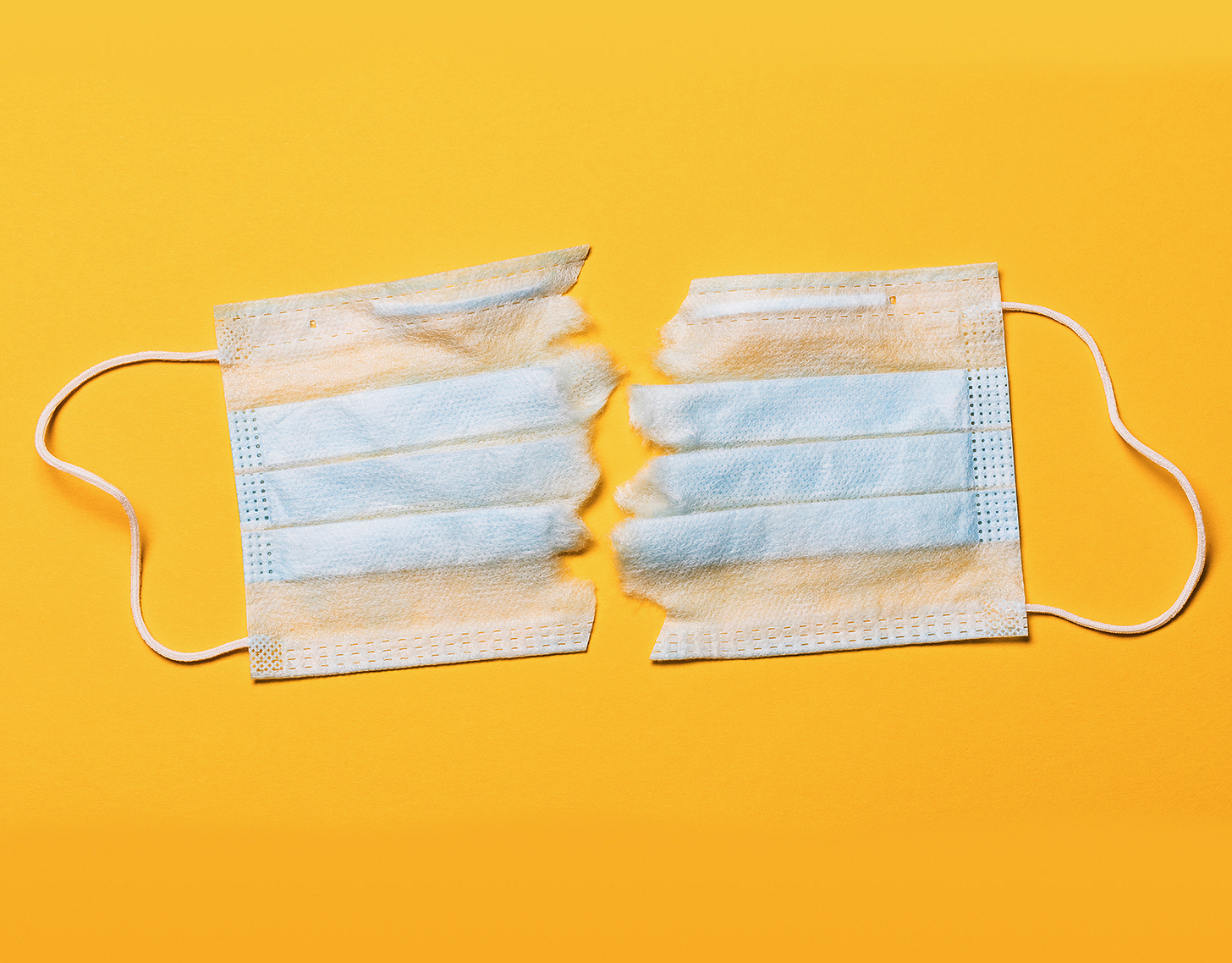The Curious Case of the People Who Want to "Reopen" America—But Not Wear Masks
Decadence and performative emoting are alive and well in pandemic America.
The coronavirus, you may have heard, is a biological weapon engineered in a Chinese lab and unleashed—accidentally?—on America by the godless communists. At least, according to Alex Jones.
That’s one theory, anyway. Another is that, yes, the virus was engineered in a Chinese laboratory, but the research was paid for by Anthony Fauci. Here’s Rudy Giuliani—former mayor of New York City, former Republican presidential candidate, and personal lawyer for the current president:
Fauci gave $3.7 million to the Wuhan laboratory. We paid for the damn virus that’s killing us.
Or, there’s another possibility, which is that the virus is actually part of a global plot being executed by Bill Gates, the World Health Organization, the Clintons, and George Soros. Here’s the president’s favorite cable news network, One America News, just asking questions:
Recent reports claim the remdesivir patent is controlled by mainland China, Bill Gates, and the WHO, while the Clintons may have a stake in it as well.
The entire cover-up is allegedly backed by globalist billionaire George Soros. What is the point of this plot? Securing the global bleachbit supply? Distracting the world from how awful Skype and Microsoft Office have gotten? The general verdict seems to be “population control,” though it’s not clear what that’s supposed to mean or why it would appeal to the likes of Gates, Soros, and the Clintons. After all, if you’re a globalist, a pandemic that radically curtails international travel for an indefinite period of time doesn’t make a ton of sense.
Then there’s another theory: That the coronavirus is the poison fruit of the vaccination tree. As anti-vax superstar Judy Mikovits explains, the vaccination regime which science—sorry, “science”—has foisted on America over the last two generations has weakened our natural immune systems to the point where a pathogen such as the coronavirus has become a much bigger deal than it would have been had we simply let nature take its course.
The Mikovits view is a far cry from the Giuliani view, but it does share one common element: She, too, blames Anthony Fauci. Though in this case, her complaint is that Fauci is part of the corrupt, pro-vaccination cabal that has buried the work of courageous truth-tellers. Like herself.
You might think that these disparate factions would be at war with one another as much as they are against Anthony Fauci. After all, if the coronavirus is a bioweapon that has been unleashed on America by the ChiComs, then some batty old lady claiming that it’s the inevitable consequence of giving kids MMR shots is part of the coverup.
And, conversely, if you’re an anti-vaxxer, then the bioweapon story is also part of a coverup: Anyone who believes it is trying to alibi Big Pharma just as surely as Fauci is.
Yet in vivo, these groups all seem to be holding hands.
Which suggests that not one of these people actually believes what they’re selling.
Here is another tell: Not one of these groups blames Donald Trump for the current state of affairs.
If you believe that the Chinese military has committed an act of war against America, then it would seem that the president of the United States has some duty to respond. Or to at least acknowledge the provocation.
Instead, Donald Trump has offered mostly praise for the Chinese regime.
Yet Alex Jones and his followers have nary a cross word for a president who is, by their own lights, at best a dupe and at worst complicit in the deadliest attack on American soil in our nation’s history.
But what if you think that there is a conspiracy on the part of some American citizens and various non-state actors to carry out what amounts to a coup—this is the OAN view. In that case, the single person responsible for stopping this shadowy group would be President Trump—and his failure to take down Gates, Soros, the Clintons, et al. is either a dereliction of duty or evidence that he’s part of the scheme.
OAN, of course, has nothing but praise for Trump.
And if you believe that Anthony Fauci is the figurehead of a disastrous regime of vaccinations that caused this pandemic, and yet the president stands at the podium with Fauci, day after day, and promises that he himself is pushing relentlessly forward in the search for a coronavirus vaccine which we will all have sooner than many people expect, well, then: You know which side Trump is on. And it isn’t yours.
Yet Mikovits and the anti-vaxxers find no fault with Trump.
The lesson here is that these stories aren’t really about vaccines or bioweapons or population control. Instead, they’re meta-parables about how the people telling them see themselves and feel about their place in the world.
It would be sad if it weren’t dangerous to the rest of us.
The bigger problem is that this sort of performative thinking isn’t limited to conspiracy-minded cranks.
Consider two of the cleavages that have opened up in the public space over the last month: one over “reopening” America, another over wearing masks.
In a rational world, the Venn diagram between people who insist on “reopening” the country immediately and the people who are militantly in favor of wearing masks in public would look something like this:

This would be a fairly intuitive situation.
If you want to end the lockdown immediately, then you will want to take any nominal precautions that will allow reopening as quickly as possible. Wearing a mask is a low-cost, high-benefit way to reduce the spread of the coronavirus, and hence make it possible to ease restrictions while lowering the chances of another outbreak.
But in reality, that is not what we’ve seen. Instead, we more or less have this:

We have a “don’t wear masks” movement that overlaps almost entirely with the “reopen immediately” movement.
There are only two possible explanations for why this might be. The first is that people are dumber than a bag of hammers.
The second is that when people tell you what they think about “reopening” and “masks,” they aren’t actually talking about the coronavirus. They’re telling a story about how they see themselves and their place in the world.
I realize that this is a false choice. And when you see people nodding along as Judy Mikovits claims that “wearing the mask literally activates your own virus” it can be very difficult to tease out which way the causality runs.
But on balance, I lean toward the latter explanation.
This need for storytelling, rather than engaging with the reality of our problem, is new.
In the aftermath of 9/11 there were a handful of fringe groups that came up with conspiracy theories about how the terrorist attacks had been an inside job, or the work of the Mossad, or a hoax. But these sentiments were limited to a fraction of a percentage of the population.
Instead, we saw a large rally effect in which the vast majority of people held hands and demonstrated solidarity and resolve commingled with a great deal of tolerance. People embraced their elected leaders and venerated the heroes on the line. There was a serious study of what actually happened. There was an uptick in crimes against and bullying of American Muslims immediately following 9/11, but the magnitude was not nearly as high as we feared it might be and this ill effect quickly dissipated.
The post-9/11 American esprit de corps did not last forever, but it lasted for better than a year.
We are barely 12 weeks into the COVID-19 pandemic and the country is already deeply divided.
Yes, there is a solid majority in favor easing mitigation measures at a prudential pace. And yes, close to three-quarters of Americans say they plan to wear masks in at least some situations. But that means there is a non-trivial number of Americans—maybe it’s 1-in-10, maybe it’s 1-in-4—who are living in the bottom part of that second Venn diagram, where they don’t view the pandemic as an event to be managed, but as an opportunity to posture and perform.
In part, this is an artifact of how successful the mitigation measures have been: Because the death toll has been held to the scores of thousands, many people have the luxury of talking and acting however they like without facing real-world consequences. They can hang out in the bottom of that second Venn diagram if it makes them feel better. (Not everyone hanging out there has been so fortunate.)
But the existence of this impulse is worrisome on its own.
As America’s decadence has increased over the last 30 or so years and we have become—just objectively speaking—a less serious country, one of the stories we have told ourselves was that we could become a serious people again if we faced a big enough shock or a stern enough test. That the steely, strong, serious America of the last century—the America that survived the Depression and crushed the Nazis and put men on the moon—was still somewhere within us, just waiting to be awakened. That our true, best selves just needed a call to action, a grave, existential summons.
The reaction of this vocal and sizable minority to the pandemic suggests that this story might not be true, either. Yes, many people have risen to meet the challenge of the moment—most notably doctors, nurses, and other health care workers, but also grocery store and delivery workers and others. And yes, there have been hopeful signs of the American can-do spirit of crisis entrepreneurialism, as in the rise of the mask-making cottage industry.
But the restless grumbling of the open-it-all-up, masks-be-damned crowd should concern us, not only because their actions endanger them and us, but also because of what it says about the American character.



